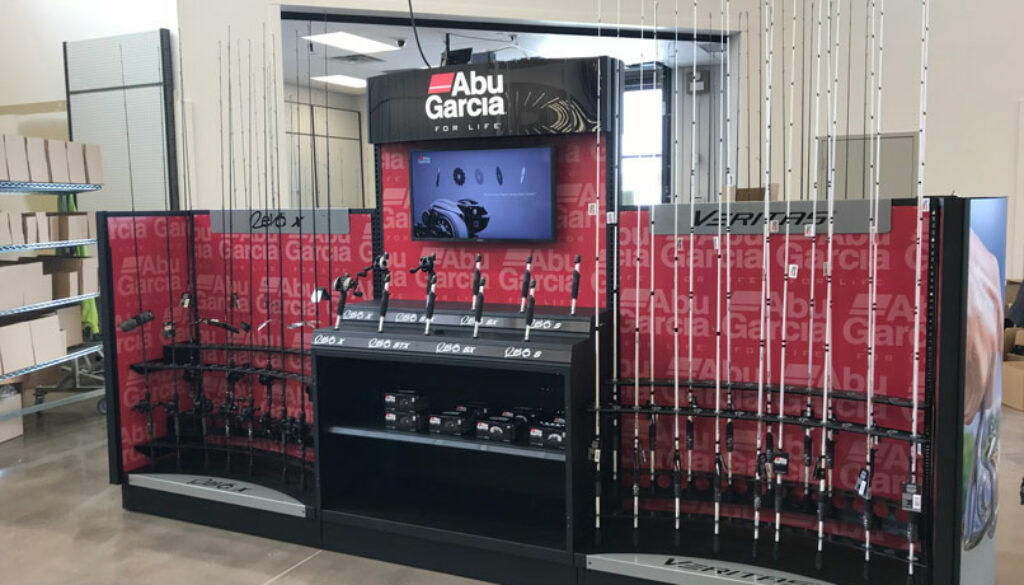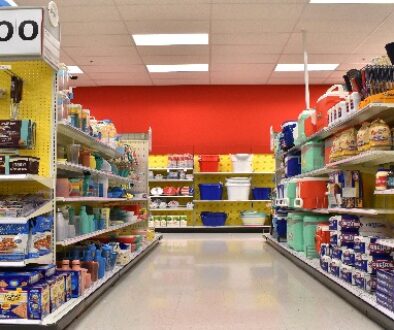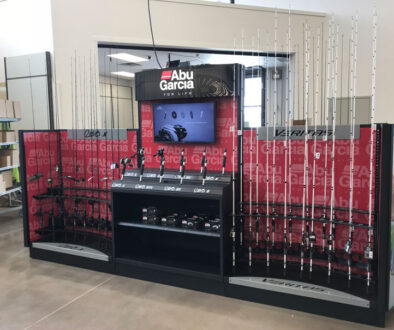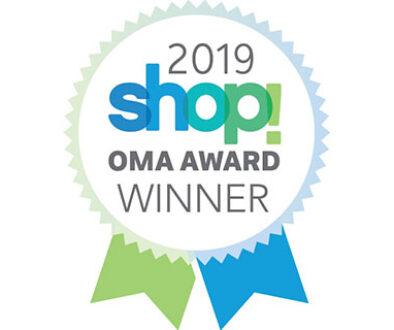Were You Aware of These Customized Display Benefits for Branding?
Have you ever thought about the story behind your brand?
Perhaps your company—like McIntyre Manufacturing —has been around for decades. Maybe it’s a family-run business that provides the best in customer service. You need to let your customers know this information, and custom merchandising displays are the way to do it.
We’ll take a look at a few vital and important elements of a customized retail display—elements that can benefit both your brand and your bottom line.
We’ll focus on branding, great design using the rule of thirds, and why it’s never too early to start designing a holiday display.
What Is Branding and Can a Customized Display Help?
So, what is a “brand”? That’s tricky to describe.
David Ogilvy, often called the “Father of Advertising,” realized that a brand wasn’t something that could be easily defined. He called it “the intangible sum of a product’s attributes.”
A brand is much more than a name or trademark or a logo. It’s what potential customers think and feel when they hear about your company, according to information from Forbes magazine.
In fact, more than half of consumers—64 percent—believe in building relationships with brands that share their same values.
If they feel a brand “represents them” and what they believe is important, they are more likely to purchase that product, according to Shopify.
How can you use a customized display to help tell your brand story?
We’ve got seven useful tips for you.
7 Ways a Customized Display Can Tell Your Brand Story
Your business is much more than a logo or a name, and custom merchandising displays are the messengers that help develop perceptions in the minds of potential customers.
1. Displays allow your message to stand out.
Don’t get lost in “action alley.” Whether you want a powerful end cap display or you’re trying to take advantage of upselling and cross-selling, a clear message is vital to capture customers.
This message is more than just “buy now.” It should be one that conveys a sense of quality to the client. It’s also important that your presentation implies what you value.
For example, Millennials are particularly sensitive to what a brand values. Seventy percent of Millennials will spend more money on a brand if it supports causes they care about.
Use your custom POP display to get that message across through clean typography, clear storytelling and maybe even digital elements.
Not sure where to get started? We understand. Sometimes it’s hard to piece together a picture that goes with “value” and “quality.” But we’ve got you covered.
Our engineers are not just technologically skilled, they’re also brilliantly creative, bringing both sets of abilities to your project to ensure its success.
2. Merchandising displays help maintain consistency.
Did you realize that the correct use of color can increase brand recognition by as much as 80 percent?
Of course, your brand is more than a logo, but your logo needs to be consistent. There’s a reason McDonald’s uses a particular shade of yellow for its “golden arches” and why there is a distinct hue in Coca-Cola’s red packaging.
Custom displays are a part of that. Through our use of powder coating we can exactly match your Pantone color.
3. You control the customized display development process.
When you create your own customized display, you are working closely with us from start to finish. Therefore, you can be assured that the end result will be your vision.
This helps ensure consistency of your brand throughout all channels—you don’t want to have a display look one way in one store and be slightly different in another.
In fact, presenting a brand consistently can increase revenue as much as 23 percent.
4. You can implement permanent signage with a customized display.
This ties in neatly with #3 above. While flexibility is important—especially with the increase in “pop –up stores” – having some permanent elements enables you to have another layer of control in how your brand is perceived.
You will also rely less on store managers to present the elements the way you prefer.
5. Custom merchandising displays allow you to update when needed.
Ideally, your branding program will run like a well-oiled machine. But sometimes, changes are inevitable.
Whether this means a merger, a new CEO or a different mission, you can effectively use your customized display to get this point across.
6. A Customized Display gives you an opportunity to boost co-branding efforts.
Suppose you’re a retailer who manufactures athletic shoes and accessories such as socks, sweatbands and t-shirts. Maybe you’re equally known as both a creator of computer games and of video game consoles.
You can use one type of display to showcase your “headliner” product, and a similar display—such as an endcap display—to cross sell your complementary products.
7. Buy into consumer psychology with the power of color.
If you’ve not settled on an official logo color, or if you’re deciding on a complementary one to enhance your brand message, don’t overlook the powerful impact that color can have on consumers.
Some hues such as blues and orange can indicate anticipation or positive feelings while others may have the opposite effect, according to Forbes magazine.
You might find it interesting to know that one-third of the world’s top 100 brands include the color blue in their logo.
One important caveat: Be sure if you’re an international company that you have checked the cultural messages that color sends to your target audience.
For example, in China, red is considered a hue of good fortune. You can read more about color’s impact on consumers and the nuances of customer psychology in our earlier articles.
Why Is Branding So Important? We’ve Got Some Statistics
Did you know that it takes roughly five to seven interactions before people will remember a brand?
Or, that color improves brand recognition by 80 percent?
These are a few of the neat facts from SmallBizGenius.
In addition:
- 73 percent love a brand because of helpful customer service
- 73 percent of consumers prefer brands that personalize the shopping experience.
- More than 70 percent of brand managers think building an audience is of vital importance—even more important than converting sales.
Ready for Your Customized Display? Don’t Delay!
You’ve been establishing your reputation for decades. We understand that. Allowing us to work with your project is a sacred trust, and that’s why we create production-grade samples of any of our displays for your review.
This step helps ensure that your vision is being met, and it supports your hard-earned reputation. We want to be your partner in success.
Take a look at what we’ve done for other clients. We’d love to be able to apply the same award-winning principles to your project.
The Importance of the Rule of 3 for Your Customized Displays
What do Leonardo Da Vinci and a well-designed POP display have in common? They both recognize the importance of the “rule of 3,” also known as the rule of thirds.
This is a key point of good design, and implementing it into your project will enable you to maximize the impact of custom store displays from seasoned display manufacturers like McIntyre Manufacturing.
But what is this rule of three, and why should you care? We’ll evaluate point-by-point how simple design elements can enhance your bottom line.
The Right Sign = A Good Bottom Line
The right signage is a part of this rule, and research studies confirm that effective signage affects your bottom line. According to a Brigham Young University study, displays with signage outsold those without signs by 20 percent.
But perhaps even more surprising was that merchandise that was not on sale outperformed clearance items by 18 percent when signage was a part of the POP display.
Scientifically, human beings are drawn to symmetrical, orderly objects and our eyes tend to linger on them for longer than they do on asymmetrical objects. The rule of three draws upon these principles to create a design that is created with perfect balance in mind.
What is the Rule of 3?

The rule states that any image—whether it be a design for your custom retail display or a painting—should be broken into a grid with two vertical and two horizontal lines. The result is nine equal squares. The most important elements of the item should be put along these lines and where they intersect.
We’ve even provided an illustration for you. Notice in the picture of the hot air balloons how the action and composition seem to be centered at the lines and the red circles at the intersection of those lines.
Think of it this way: when you want someone to notice something, you generally point to it. The principles in the rule of three work the same way: Your design is “pointing” to something you want your customer to notice.
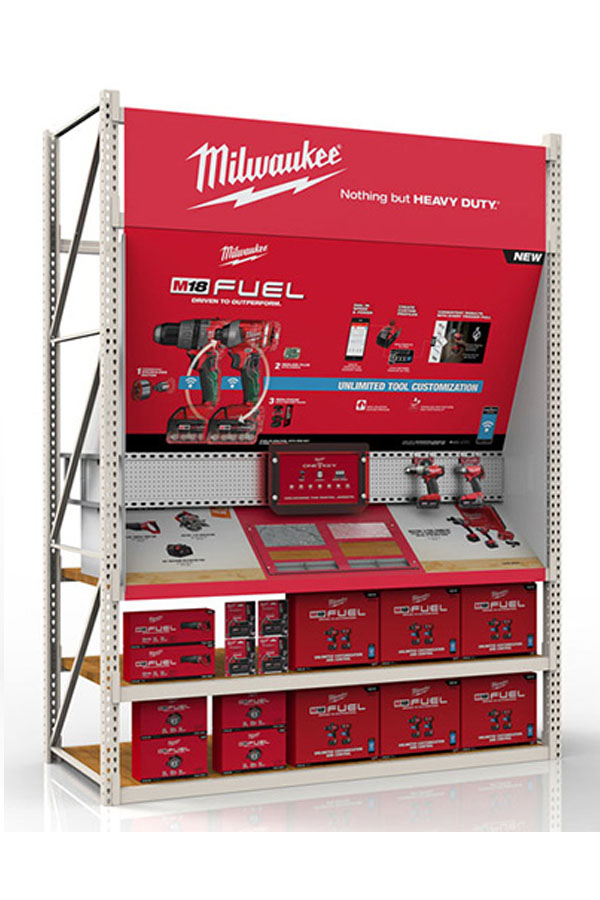
You’ll see this a lot in landscape photography, but it’s a key element in keeping your POP display interesting and provides a stronger impact on their work.
In fact, take a look at how the rule of three neatly applies to this display we did for Milwaukee. Notice how the horizontal lines draw the viewer’s attention to information about the product, drawing their eye to the messages that are so important to a solid branding strategy.
Of course, there’s much more to good design than the rule of three. We look at several other elements in design as well. These include:
- Hierarchy of items- We make sure that important elements are bolder and at key focal points. This is particularly important as it relates to the font size.
- Balance – As mentioned earlier, the human eye is drawn toward symmetry. Awkward angles may be interesting to get a brief flash of curiosity, but studies indicate that the eyes tend to linger longer on symmetrical items.
- Complementary images – Make sure all images look cohesive and as if they were a part of the same photoshoot.
Display Manufacturers Are About Much More Than Great Graphic Design
Don’t misunderstand: Design is important. Statistics clearly show the importance of how it can result in more sales and stronger brand recognition. We’ve even won awards for the execution of great designs for custom retail displays.
But there’s also the nuts and bolts of the product. How will it be shipped? What material should be used? Will it need to be assembled?
We have a comprehensive plan for you and your project, whether you have a clear, detailed vision or just some ideas you’ve sketched on a Post-It note, see why, as great display manufacturers, we have so many loyal customers.
5 Do’s and Don’ts for Holiday Displays
It’s never too early to plan for getting your product on shelves in time for Christmas, Easter, July fourth or other holidays. Custom merchandising displays take time to plan, build, and ship. If it’s too late for this Christmas, start researching and planning for Valentine’s Day or Saint Patrick’s Day.
Let’s take Christmas for an example:
Some shoppers may groan at the “Christmas creep”—the way Christmas items sneak into stores as early as August or September— but there’s logic to this process.
According to a Facebook study, last year around 48 percent of shoppers started their holiday shopping in November or earlier. Many cross the “to buy” items off their list starting as early as October.
The survey also indicated that in 2018, half of consumers had completed their holiday shopping by December 3.
So it should be no surprise that stores will be full of custom merchandising displays and wire grid display racks, heralding Christmas items, as early as October.
If there’s one important resounding message you can take from this, it’s that it’s never too early to start planning for your next holiday display.
When competing for attention from hundreds of products, carefully planned and dynamic custom merchandising displays can make the difference between securing a sale and being overlooked.
Here are 5 Do’s and Don’ts for holiday displays that will help you get the most out of your seasonal sales, whether you’re preparing for Christmas, Independence Day, or something in between.
Important Do’s and Don’ts for Holiday Displays
1. Do Keep Your Focus for Your Custom Merchandising Display
If considering a Christmas display, there are several different directions you can take. Should you go with Santa or snowmen or just concentrate on a comfy winter scene?
Whichever one you choose, make sure you focus on one key element for your custom merchandising display. Don’t send mixed signals by trying to do too much.
2. Don’t Try to Do Everything at Once
Returning to the example above, there are dozens of different combinations of images you can use for a Christmas display, but if you overwhelm your customer with all of them, your message is lost as they are bombarded with sensory overload.
Remember to provide clear information with a basic call to action on your display.
3. Do Plan Your Display with Social Media in Mind
The Facebook survey mentioned earlier also indicated that, according to holiday shopping data, 69 percent of shoppers believed that social media was a great resource to find out more about new products.
Another 62 percent became interested in a brand or product after seeing it featured in Facebook’s Stories or on Instagram.
You have to sell a story through experiential shopping, and a custom merchandising display is key to doing it.
Millennials are all about experiential shopping, and this demographic represents roughly $200 billion in buying power, according to Forbes.
You can’t afford to ignore the marketing power of Millennials, and Millennials share their experiences on social media.
Generation Z, the generation that follows the Millennials, are also social media experts.
They represent $44 billion in purchasing power. In fact, while they’ll still visit brick-and-mortar stores, 45 percent will use social media outlets such as Snapchat while in a store.
What does this mean for your display?
Make it inviting. Make it creative. Make it something that will encourage a photo and a share on Facebook or Instagram.
So, at the end of the day, you have to ask yourself, is your custom merchandising display or wire grid display rack worthy of a tweet?
4. Do Tap Into Urgency and Scarcity
It’s how we’re wired.
By using your custom merchandising display’s messaging to create feelings of urgency and you tap into a powerful part of consumer psychology. These messages reflect the “hurry, buy now before they’re gone” mentality.
According to studies published by the International Review of Retail, Distribution and Consumer Research, messaging that emphasized scarcity and urgency caused several examples of in-store hoarding.
In-store hoarding occurs when someone picks up an item and carries it with them throughout the store before deciding whether or not to buy it.
Tapping into urgency and scarcity is key to getting customers to interact with your product by placing it in their cart. This increases the chances that you’ll make a sale.
5. Don’t Use a One-Dimensional Display
More creative shapes and forms create engagement, which can go a long way toward interesting people in your product.
If you really want to stand out from competitors, you want to create the experiential shopping that customers are looking for.
The Facebook study on holiday shopping trends showed that almost half—42 percent of all U.S. Holiday shoppers — stated that they shopped in-store because they liked the holiday ambiance.
Another 27 percent said they shopped in brick-and-mortar stores to spend more time with family.
It’s difficult to create a compelling ambiance if you’re showcasing a one-dimensional display. Try to utilize the power of interaction, whether your display features a charging station or a great way to engage with different varieties of fishing poles, as we did in the case of Pure Fishing.
McIntyre Manufacturing: Providing Quality Customized Displays No Matter What Time of Year
Decades. Many people use this term, but what does it mean in the context of your customized display?
At McIntyre manufacturing, it represents our loyal customers—many of whom have been with us for more than 10 years. These customers know they’re also dealing with a dedicated workforce.
We have several employees who have been with the company for more than 20 years. Contact us. We’re happy to answer any questions you have. Let us transform your vision into reality.
Since 1977, McIntyre Manufacturing Group has created custom-designed displays with an uncompromised dedication to customer service. We utilize the latest technology and attention to detail to create the finest products with excellent craftsmanship. If you can dream it, we can create it. Contact us to see how we can bring your vision to life.

